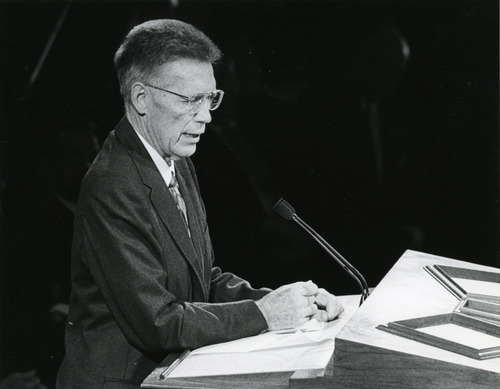This is an archived article that was published on sltrib.com in 2013, and information in the article may be outdated. It is provided only for personal research purposes and may not be reprinted.
Most Mormons did not challenge the ban on black males being ordained to the LDS priesthood, but they did want to know why God would institute such a policy.
So various explanations, many culled from American culture at the time, emerged.
Some LDS leaders, including then-apostle Bruce R. McConkie, taught that black skin was "the curse of Cain," an allusion to the biblical figure who killed his brother Abel. Others added the notion that blacks were "less valiant" in the sphere known in Mormon theology as the "premortal existence."
The official position is that only God knows the reason for the ban.
"Church records offer no clear insights into the origins of this practice," says a new preamble to LDS President Spencer W. Kimball's 1978 announcement, which is part of LDS scripture. "Church leaders believed that a revelation from God was needed to alter this practice and prayerfully sought guidance."
The preamble was added in a new edition of scriptures that came out this year. The introduction makes clear that Mormon founder Joseph Smith had ordained several black men but does not dispel any of the theological myths that arose to defend the practice.
The blacks-as-cursed belief continues to be circulated at the grass-roots level and supported in publications such as McConkie's The Mortal Messiah and former LDS prophet Joseph Fielding Smith's Doctrines of Salvation.
Last year, after Brigham Young University religion professor Randy Bott was quoted in the press describing those racist theories, the church issued a strong condemnation of the so-called "folklore."
Bott's views, the statement said, "absolutely do not represent the teachings and doctrines of The Church of Jesus Christ of Latter-day Saints."
It went on to say that "the [LDS] church's position is clear — we believe all people are God's children and are equal in his eyes and in the church. We do not tolerate racism in any form."
Neither last year's statement nor the new scriptural introduction came via a First Presidency letter read over the pulpit. Both were distributed through the news media.
That concerns believers such as LDS sociologist Armand Mauss, who has written on the subject. Because the folklore has not been officially condemned by the church's hierarchy, it still "periodically ... appears among us in unexpected places, despite the best efforts of the [church's public affairs department]."
Some Mormons go further, urging the church to apologize for the ban.
"Any celebration is only half as good without a heartfelt and sincere apology to people of African descent," says Darron Smith, a black Mormon activist who teaches physician-assistant studies at the University of Tennessee in Memphis. "An apology must also be directed to the white membership who were, likewise, led astray by the racist teachings of church authorities and, thus, crippled in their understanding of the concept of race.
Smith keeps hoping, he says, believing the church "can do better."
New explanation in LDS scripture
"The Book of Mormon teaches that 'all are alike unto God,' including 'black and white, bond and free, male and female' (2 Nephi 26:33). Throughout the history of the church, people of every race and ethnicity in many countries have been baptized and have lived as faithful members of the church. During Joseph Smith's lifetime, a few black male members of the church were ordained to the priesthood. Early in its history, church leaders stopped conferring the priesthood on black males of African descent. Church records offer no clear insights into the origins of this practice. Church leaders believed that a revelation from God was needed to alter this practice and prayerfully sought guidance. The revelation came to church President Spencer W. Kimball and was affirmed to other church leaders in the Salt Lake Temple on June 1, 1978. The revelation removed all restrictions with regard to race that once applied to the priesthood.
Source: Official Declaration 2 in Doctrine and Covenants



